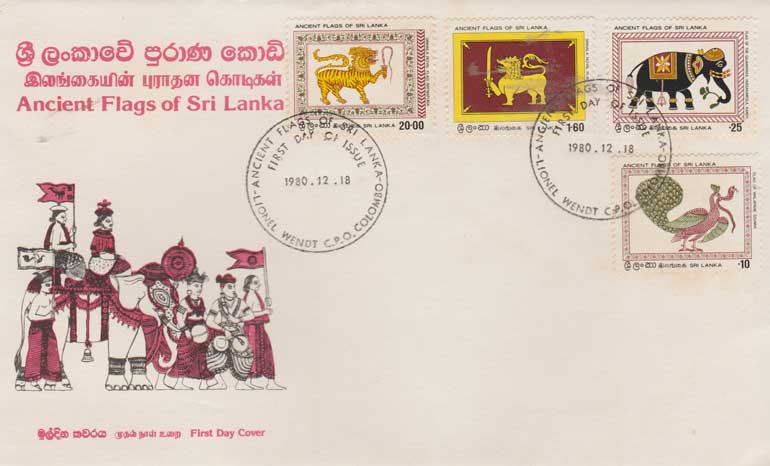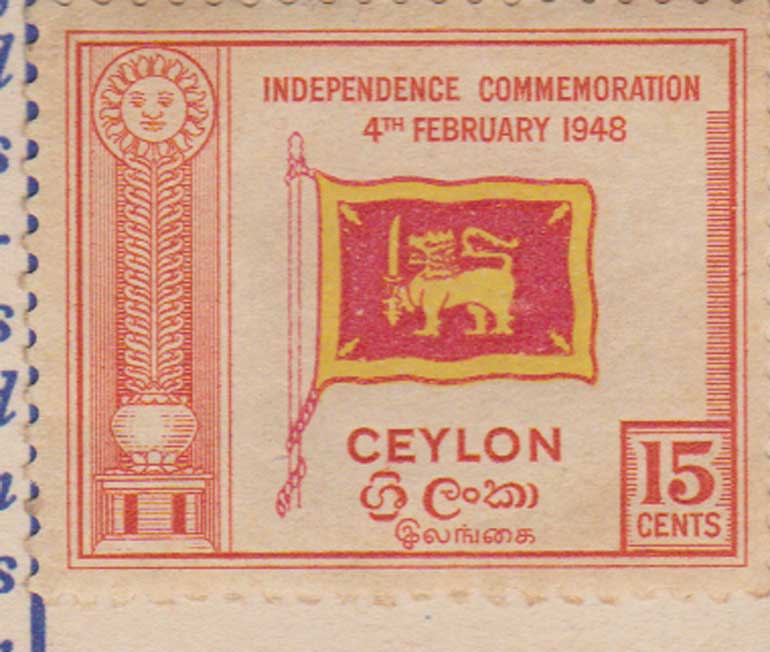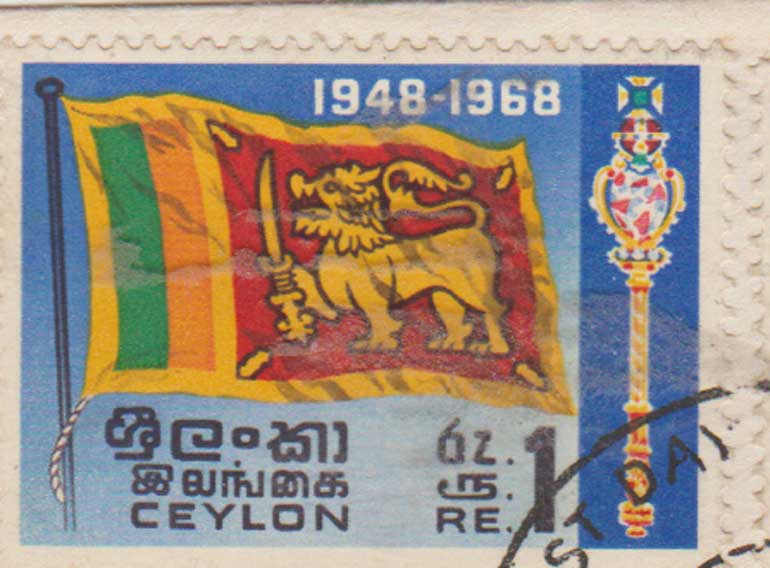Wednesday Jul 02, 2025
Wednesday Jul 02, 2025
Saturday, 23 May 2015 00:00 - - {{hitsCtrl.values.hits}}



With the National Flag being talked about these days, I glanced through my collection to see the stamps that have featured Sri Lanka flags.
The first time that the Sri Lanka flag was featured was in February 1949 when four stamps were issued to mark the first anniversary of Independence. Two out of four Independence Commemorative Stamps used the identical figure of the Lion Flag but in two different sizes. The smaller one was the 4-cents stamp and the other was the 15 cents stamp.
The legend in the souvenir folder issued with the four stamps had an interesting description on the Lion Flag. It reads: “The Lion Flag, in legendary association with the origin of Vijaya, the first chronicled King of Ceylon, had a special place in the thoughts of the Island’s inhabitants. The three lions in the gateway of Sanchi, India (circ, third century BC) have been identified as the Royal Arms of Ceylon. The arch at Sanchi contains a representation of the Bo-tree to Ceylon, and the symbols on either side of the panel, it is thought, depict the standard of Asoka and of King Devanampiya Tissa. It is even said that the three-winged Lion on the gateway at Sanchi probably stood for the three divisions into which the island was divided at the time of the visit of Emperor Asoka’s son, Prince Mahinda.
“The representations at the Dambulla Temple of the Lion with its tail in a loop, thrust downwards, sword in right paw and the Sun and Moon motifs above, which is comparatively recent, is surmised to reflect an old tradition. A Belgian physician who visited the Island in the 17th Century states that the emblem of Rajasinghe II of Kandy was a Red Lion on a Golden Field – obviously an error for a Golden Lion on a red field. The banner of the last King is stated to have been a Lion passant holding a sword in its right paw.”
This was written over six decades ago. Researchers may have disputed what has been written about the Sanchi gateway.
The National Flag currently being used was featured in one of two stamps issued to commemorate the 20th anniversary of Independence in February 1968. This was the one that was recommended by the Cabinet sub-committee and approved by the House of Representatives on 2 March 1951.
Sri Lanka’s ancient flags were the theme of a set of four stamps issued on 18 December 1980. Two of these featured the lion. One (Rs. 20) has been identified as the ancient flag of Ratnapura Royal Standard which has also been the Colombo District flag. Colombo has had three flags. This is believed to have been the flag of Sri Jayawardenapura Kotte. Here the lion in the centre holds a whip with one of the front legs and is slightly looking to its right. The whip symbolises authority. The whip was cracked before the monarch and his adigars (principal ministers in the court) marched in a procession.
The other flag with the lion (Rs. 1.60) features the flag of the last king of Kandy which was taken down when the British took over the kingdom of Kandy signifying that the entire country was under their authority. This was the flag that was spotted by E.W. Perera at the Chelsea Royal Hospital many years later. Prime Minister D.S. Senanayake hoisted this flag to mark the dawn of Independence on 4 February 1948.
Here the lion, in yellow, holds a sword on a maroon background. The lion is said to symbolise the arrival of Prince Vijaya and the establishment of the lion race. While this was the flag of the king, there were other flags assigned to various dissawas amd korales in the Kandyan kingdom. These flags are carried in the Kandy Perahera every year.
The use of figures of animals and birds had been a feature of the ancient flags. The stamp (25 cents) featuring the elephant was the flag of the Gajanayaka Nilame – the keeper of the elephants in the Sri Dalada Maligawa in Kandy. As an official of the Maligawa he was the head of the unit looking after the elephants. The caparisoned elephant with a well decorated garb also carries a flower at the end of the truck.
Both the lion and the elephant are considered lucky animals that bring prosperity. The peacock has been the symbol of Walapone Dissawa in the Kandyan kingdom for several centuries. In the 10-cent stamp which carries a dainty border right round, the peacock is carrying a serpent from its beak. Apart from the flag with a peacock, there had also been other flags in this dissawa featuring Bo leaves in the four corners or a peacock stepping on a serpent.
Discover Kapruka, the leading online shopping platform in Sri Lanka, where you can conveniently send Gifts and Flowers to your loved ones for any event including Valentine ’s Day. Explore a wide range of popular Shopping Categories on Kapruka, including Toys, Groceries, Electronics, Birthday Cakes, Fruits, Chocolates, Flower Bouquets, Clothing, Watches, Lingerie, Gift Sets and Jewellery. Also if you’re interested in selling with Kapruka, Partner Central by Kapruka is the best solution to start with. Moreover, through Kapruka Global Shop, you can also enjoy the convenience of purchasing products from renowned platforms like Amazon and eBay and have them delivered to Sri Lanka.
Discover Kapruka, the leading online shopping platform in Sri Lanka, where you can conveniently send Gifts and Flowers to your loved ones for any event including Valentine ’s Day. Explore a wide range of popular Shopping Categories on Kapruka, including Toys, Groceries, Electronics, Birthday Cakes, Fruits, Chocolates, Flower Bouquets, Clothing, Watches, Lingerie, Gift Sets and Jewellery. Also if you’re interested in selling with Kapruka, Partner Central by Kapruka is the best solution to start with. Moreover, through Kapruka Global Shop, you can also enjoy the convenience of purchasing products from renowned platforms like Amazon and eBay and have them delivered to Sri Lanka.